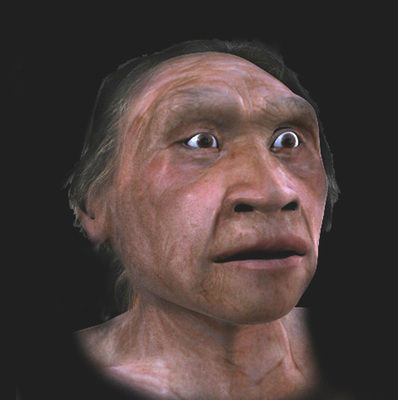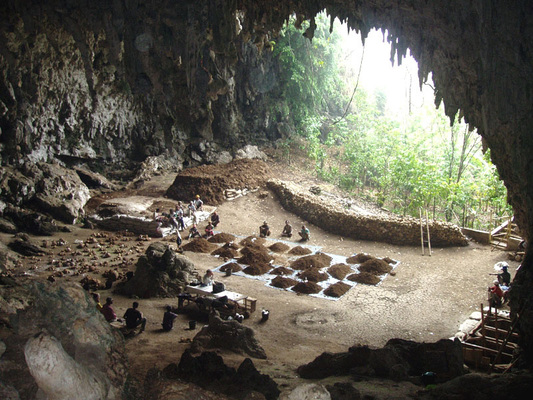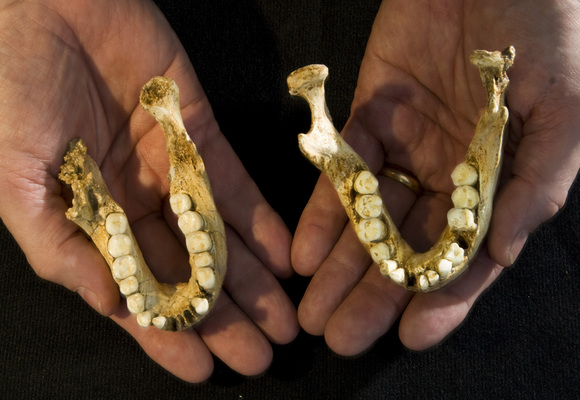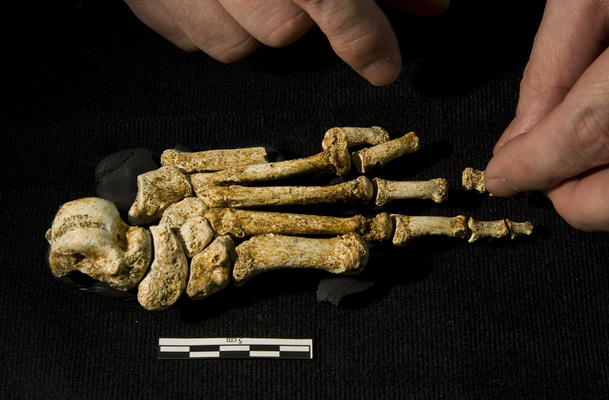
by Carolyn Gramling Thursday, January 5, 2012

A computer animation of a hobbit. PixelDust

Ling Bua cave, on the island of Flores in Indonesia, where the Hobbit was found. Annamaria Talas

Two lower jaws found at the dig site in Flores. The hobbit's teeth give important clues to its origins. Djuna

The hobbit's foot may be key to determining its origins. Djuna
For many years, local legend on the Indonesian island of Flores told of an elflike creature with large feet and a voracious appetite that lived alongside humans. Flores was already a mythical sort of place, featuring (now-extinct) dwarf elephants, Komodo dragons and giant rats the size of rabbits.
Then, in the 1990s, scientists visiting a limestone cave on the island found ancient stone tools dating back hundreds of thousands of years. That was a considerable puzzle; humans weren’t supposed to have reached the island until 12,000 years ago. Prior to that time, Flores was thought to be isolated by the Wallace Line, a zoographical division separating the fauna of Australasia from those of mainland Asia. The division is thought to be the result of a row of deep ocean trenches marking the plate boundaries between Australasia and Eurasia, which produces forbidding currents and powerful waves.
For two years, the scientists dug deeper into the cave floor, excavating some 16 or 17 meters underground. They first found an arm bone, then uncovered more bone fragments, including a skull and a complete lower jaw. The bones were lying in sediments dated to about 30,000 years old — suggesting that their owners had at least coexisted with humans. They were tiny; scientists at first assumed the bones belonged to a female child. But, they discovered, the skull and jaw had fully formed — and worn — wisdom teeth.
The bones, the researchers concluded, belonged to an adult — a tiny, one-meter-tall adult — that represented a new species of hominid. The scientists dubbed the species Homo floresiensis, and gave it an oddly appealing nickname: the Hobbit.
But not everyone was convinced; many believed the Hobbit was merely a malformed modern human. In the ensuing years, the wrangling back and forth between believers and skeptics in the Hobbit-as-a-species debate has been epic and often emotional, drawing ever broader experts in for a closer look. Accordingly, the arguments for and against its species status have become more and more complex and difficult to sort out.
That’s what makes PBS NOVA’s new hour-long documentary “Alien From Earth” so helpful. Although it doesn’t present any startling new discoveries, it carefully and methodically sifts through the existing evidence, telling the unfolding story of the Hobbit in a very accessible and understandable way. And with so many conflicting possibilities — and no known DNA evidence to help settle the question — the Hobbit story remains compelling, challenging some of the most basic assumptions scientists have about the human evolutionary tree.
The dissent has raged over many issues: How and when did the Hobbits get to Flores in the first place? Could creatures with a brain a third the size of modern humans even make the sophisticated stone tools found nearby? Could microcephaly or some other pathology be responsible for the tiny size of the skull and the individual’s diminutive stature? Can the shape of the Hobbit’s wrist bones provide the final answer to whether Hobbits were modern humans or more ancient cousins? And if they are a new species, just how ancient are they — are they most closely related to Homo erectus, or possibly to the far older Australopithecus?
Dozens of scientists appear in the movie to weigh in — director/producers Simon Nasht and Annamaria Talas seem to have interviewed just about everyone who’s commented one way or another on the Hobbit issue in the last few years. That adds to the Hobbit’s import — as one scientist notes, given the fundamental questions that the Hobbit’s status raises, whole reputations, even careers, are on the line.
Among the more far-reaching issues at stake is the progress of the human evolutionary tree outside of Africa and beyond Australopithecus, which can seem roughly linear through Homo habilis, Homo erectus, Homo neanderthalensis and finally Homo sapiens. What if a tiny cousin of Homo sapiens co-existed on a remote island over the past 80,000 years? Are there other branches of the family tree that lived, died and became extinct, and about which we know absolutely nothing? What if Homo erectus left Africa about 1.8 million years ago and headed out across Asia, producing new variants on the family tree along the way, some of whom became isolated and evolved into a tinier species on a remote island? Or what if tiny Australopithecus — despite her small brain and body size — turned out to have been capable of traveling such great distances 2 to 3 million years ago?
Perhaps one of the most compelling moments in “Alien From Earth” comes toward the end. The filmmakers visit a small medieval town in Georgia (the country), where five tiny skulls have been found in the last decade. The skulls are remarkably similar to the Hobbit’s — but at 1.7 million years old, they are the oldest human ancestors yet found in Eurasia, and possibly the forebears of the Hobbit.
With so many voices and opinions appearing and weighing in, who says what and who believes what can become a bit confusing, and it would have been helpful if “Alien From Earth” were a bit more consistent about throwing up a label to remind me about who was speaking. But that’s a minor quibble — overall, “Alien” does a solid job of putting together the complex Hobbit story — a tale that can feel nearly as convoluted as the human evolutionary tree itself. Catch it tonight at 8 p.m. EST on PBS NOVA, or visit the Web site for more information.
© 2008-2021. All rights reserved. Any copying, redistribution or retransmission of any of the contents of this service without the expressed written permission of the American Geosciences Institute is expressly prohibited. Click here for all copyright requests.